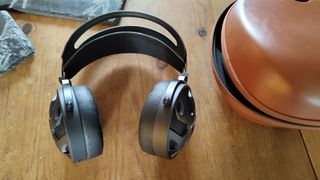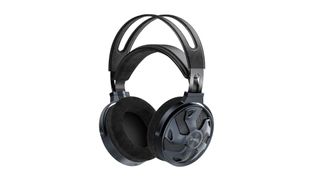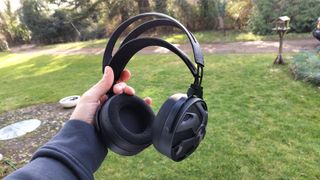Despite Fiio having been around for a good 15 years or so, the open-back FT3 are the Chinese brand’s first-ever foray into the world of over-ear headphones. Fiio is better known to most as a purveyor of portable music players, desktop amps and in-ear monitors, but its recent delves into the realm of over-ear cans could have the more established names in the business looking over their shoulders somewhat – if the quality is up there, of course.
At this price level, there’s no shortage of competition, and while wireless headphones have certainly become a dominant force in recent times, wired headphones, including open-back ones such as the FT3, will always have their place. Has Fiio done enough, though, to tempt you away from the front-runners in this arena, including some fantastic established class leaders from the likes of Grado, Sennheiser and Beyerdynamic?
Price
The FT3’s official launch price stands at £289 / $299 / AU$449, a tag which places them somewhere within the mid-priced portion of the cost spectrum.
In terms of more direct competition, the Award-winning, open-back Grado SR325x will cost you around £249 / $295 / AU$419, while the Sennheiser HD 600, which are also wired and open-back, retail at around £350 / $399 at the time of writing. We also tested the Beyerdynamic DT 900 Pro X at £219 / $299 / AU$369, although prices have dropped a tad since then.
Comfort
In terms of general comfort and usability, the FT3 have most of the bases covered, and we’re immediately pleased to find two pairs of removable ear pads – one in suede and the other predominantly leather – provided in the box as standard. After a time, there is a danger that those large, all-encompassing pads, especially when adorned in suede, can hold enough heat to make your ears feel rather toasty, but we find that becomes an issue after more extended listening periods.
Fiio FT3 tech specs
Type Over-ears, open-back
Drivers 60mm dynamic
Claimed frequency response 7Hz – 40kHz
Cable 3m
Dimensions (hwd) 26.9 x 23.3 x 13.5cm
Weight 391g
It’s worth noting that not only will obvious factors such as your choice of music and source player affect the sound of the Fiios, but the headphone pads you opt for will also impact the sound somewhat. Not only are the alternative leather options provided a little easier on the ear when it comes to preventing excessive heat, but they’re also the logical choice for anyone who favours a slightly leaner, more immediate profile to their music.
More generally, the overall feel and fit of the Fiios are satisfactory, albeit with room for improvement. The headband itself, adorned with handsome leather, flexes satisfactorily to the contours of your skull, while there’s rarely a hint of excessive pressure or clamping once you’ve got the affordable cans in place. You can undoubtedly get lighter open-back pairs, but when placed side-by-side with the Sennheiser HD 600 during testing, we don’t feel weighed down or over-encumbered when switching to the Fiios.
The one thing we’re not that convinced by is the FT3’s capacity to accommodate different head sizes. Many cans simply provide a slider which noticeably reveals more or less of the overall headband’s length, moving or clicking back and forth to give you an appropriate fit. The Fiio’s internal headband doesn’t do this, instead stretching like elastic to accommodate your dome as best it can but never allowing itself to constrict back to facilitate a snug, tight experience. It works for getting the headphones over your skull in the first place, but any head wriggling or excessive movement will be enough to dislodge them, such is the rather weak nature of the overall clamping effect. Many of our team tried the FT3 on, with those smaller-headed members struggling to get a truly satisfactory fit.
Build
Slight issues with fit aside, Fiio has done a solid job ensuring that the FT3 look and feel the part. Sure, they aren’t adorned with anything that will make your jaw drop, but they’re robustly made and feel relatively hard-wearing, with a sturdy, flexible construction that bends and flexes without feeling strained in any of the usual weak spots. Were we to have even more time with them, we’re confident the FT3 would be resilient to the sort of cracks, strains and snaps that can tear a good pair of headphones asunder.
The FT3 also boast high levels of source compatibility thanks to their range of interchangeable connector plugs, with Fiio furnishing users with 3.5mm and 6.3mm (single-ended) or 4.4mm and XLR-4 (balanced) connectors to ensure that you’re able to listen via a variety of portable music players, laptops, smartphones and DACs. Those are all included in the box, as is a rather chunky, but undeniably well-made, leather case. There’s also a 3m connector cable that, while many users will enjoy the freedom and distance that it provides, can be a hindrance for others who find it to be prone to getting snagged on any nearby pieces of furniture or gangly trailing limbs.
We are, however, more enthusiastic about the way Fiio’s trailblazing cans look, and while these things are subject to personal preference, the designers have made an effort to make their first-ever over-ears stand out from the crowd. That two-piece leather headband is a nice touch, and we also rather like the cups’ outer shell design which puts you in mind of a sports car’s customised hubcaps.
Sound
It feels like there should be a catch looming here, like a Leviathan lurking beneath the otherwise pristine and undisturbed waters of a clear, calm ocean. Happily, the Fiio don’t let us down sound-wise, even if there are areas in which they harbour comparative weaknesses. We hook the cans up to our Astell & Kern A&futura SE180 portable music player and see how the FT3 deal with a recording of Radiohead’s Calculate – immediately there’s clarity and crispness to those opening cymbal clanks before the warm sweetness of Jonny Greenwood’s guitar finds its place within the arrangement. As things build, the Fiios allow the whole track to blossom and expand, rewarding us with a spacious picture that unfurls before our very ears.
The FT3 start well, but do they have the muscle to go with their musical insight? A 24-bit/192kHz FLAC recording of Why Do We Fall? from The Dark Knight Rises OST provides us with the answer as the Fiios harness the weight and energy of Hans Zimmer’s brooding slow-burner to give a convincing, robust listening experience. They’re not quite at Bane-levels of strength and brawn, but Batman himself would still be proud of the effort put in by the Fiios and our A&K portable player.
In terms of insight and transparency, the signs also appear positive for the FT3. They convey with solid authority the meaty crunch of Bad Religion’s foot-stomping 21st Century (Digital Boy), as well as the carefree, sun-soaked vibes of Gorillaz’s Humilitymaking strong efforts to convey the emotion and feel of each respective tune. There could be more authenticity and analysis on display during a Tidal FLAC recording of One Republic’s I Ain’t Worriedsomething you certainly get with the Sennheiser HD 600, but the FT3 still do an admirable job of making you want to don your board shorts and start playing touch football on the Californian sands.
We switch to the Grado SR325x, though, and things are taken to a new level, especially with regard to timing, dynamics and transparency. We pick out Kid Cudi’s Day ’n’ Nite, and the sharpness and impact of the rhythm conveyed by the Grado on-ears is more than anything the Fiio cans can muster. An older recording of Beethoven’s Moonlight Sonata again feels like more of a showcase for the Grados than our actual review subjects, offering greater depth of tone and knack for dynamic contrast than the FT3’s game effort.
Here, then, we find the noticeable drawbacks of these likeable debutantes. While the Sennheisers offer commendable levels of transparency and spaciousness, they’re also a touch more precise and detailed than the Fiio FT3, the latter of which are just a little hampered by their tendency to colour all music, no matter its genre or provenance, with their slightly more relaxed, comfortable style. The Grados, conversely, offer more in the way of dynamism and musical understanding, picking up on the intricacies and personalities of given recordings with more élan and insight than the FT3.
Verdict
The Fiio FT3 remain a strong debut. For what is a reasonable outlay, these likeable open-backed cans are solid performers, offering a good build and a sound profile that we found to be pleasant, unchallenging and easy to listen to, even if rivals in this area can offer more dynamic interest, rhythmic ability and/or precision and detail.
SCORES
MORE:
Read our review of the SR325x grade
Also consider the Sennheiser HD 600
Read our Beyerdynamic DT 900 Pro X review
Best over-ear headphones: wired and wireless over-ears for every budget













